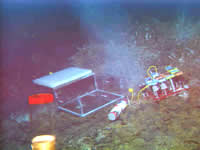| |
Teacher Logbook - NOAA Ship Ron Brown
| |

The elevator, loaded with experiments,
is deployed from the ship prior to
dive
R629. The instruments (experiments) were placed at Cloud vent on the
'98
lava
flow.

Cloud vent is in the background, surrounded by scientific experiments
and
gear.
The box in the center is a biology box (bio-box), which was used to
transport
the arrays to the elevator after their one-week deployment. The colorful
rectangular object on the right is a larval settlement array. The
tube
lying in
front of the bio-box is a larval trap. Two larval settlement arrays
and four
larval traps remain at Cloud for a one-year experiment |
|
Jeff Goodrich's Sealog:
Axial Volcano - 1998 lava flow
July 27, 2001
Deploying
and recovering instruments from the ocean floor is no easy task.
It
takes many skilled people and a lot of ingenuity. The science party brought
along two PMEL engineers, Chris Meinig and Nick Delich, who perform a
multitude
of tasks while on board and in the office (where they design and test
the
instruments needed for research cruises). The engineers are assisted by
Bruce
Cowden, the chief bosun, and the ROPOS crew while preparing the instruments
for
deployment and recovery. Their biggest challenge thus far was to overload
an
aluminum-rail elevator three times its maximum load, deploy it, sink it,
unload
it, load it back up, release it from the bottom, and recover it all during
daylight hours. It's nearly impossible to see and recover even brightly
colored
objects at night.
Working with
biological oceanographer Anna Metaxas, their first task
involved
reinforcing the aluminum-rail elevator by wrapping it in a nylon sling
to
make
the maximum load-carrying capacity higher. Next, a spreadsheet was designed
to
calculate the weight of the instruments plus the elevator in air and under
water. This is tricky because there's no easy conversion between the two.
Different materials weigh different percents of their air weight, once
in
water.
With the total weight calculated for deployment, they then calculated
the
total
weight during recovery for the instruments that were coming up from the
seafloor.
Next, the
correct buoyancy is calculated for the given weight, and a number
of
large yellow floats are attached to the elevator to raise it from the
seafloor.
With buoyancy added, they must then calculate how much weight must be
added
to
sink the elevator to get it down to the bottom during deployment. A weighted
railroad-car wheel is attached to the underside as an anchor for sinking.
To
raise the elevator off the bottom, an acoustic release is added to free
it
from
the railroad wheel anchor. The instruments in the elevator need to be
secure
for
the ride up or down but also be accessible by the limited dexterity of
ROPOS.
Sound complicated? It is. That's why we have engineers.
With the
elevator finally ready, they deployed it this morning with no
problems.
All the new experiments/instruments were deployed on the bottom, where
they
will spend the next year. Experiments that were finished were placed in
the
elevator. Dive R629 was a success, at least we hope so, as the elevator
is
still on its way to the surface. When the experiments are safely on board,
we
will all breathe a sigh of relief.
|
|

